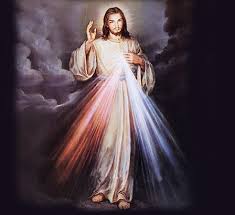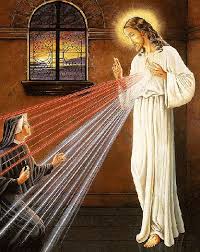The Chaplet of the Divine Mercy is a Roman Catholic devotion based on the visions of Saint Mary Faustina Kowalska (1905-1938), known as "the Apostle of Mercy." She was a Polish sister of the Congregation of the Sisters of Our Lady of Mercy and canonized as a Catholic saint in 2000.
The chaplet is often said as a rosary-based prayer with the same set of rosary beads used for reciting the Holy Rosary or the Chaplet of Holy Wounds. However, the chaplet may also be said without beads, usually by counting prayers on the fingertips.
Message and promises
According to Sister Faustina's visions, written in her diary, the chaplet's prayers for mercy are threefold: to obtain mercy, to trust in Christ's mercy, and to show mercy to others.
Still, according to Sister Faustina's visions, Jesus Christ promised that all who recite this chaplet at the hour of death or in the presence of the dying will receive great mercy. She wrote that Jesus said:
"....When they say this Chaplet in the presence of the dying, I will stand between My Father and the dying not as the just judge but as the Merciful Saviour."
Jesus also promised that anything can be obtained with this prayer if it is compatible with His will. Sister Faustina recounts in her diary that, in her vision, she saw an angel sent to a city to destroy it. Sister Faustina began to pray for God's mercy on the city and felt the strong presence of the Trinity. After she prayed the internally-instructed prayers, the angel was powerless to harm the city. In subsequent revelations, Sister Faustina learned that the prayers she spoke were to be taught to all the people of the world.
According to Roman Catholic tradition, the chaplet may be said at any time, but it is said especially on Divine Mercy Sunday and Fridays at 3:00 PM. The Chaplet is prayed daily at the National Shrine of The Divine Mercy in Stockbridge, MA. In the Philippines, Singapore and Hong Kong the "3 o'clock Prayer" is broadcast on radio broadcasting & television stations daily at 3:00 p.m. In 2000, Pope John Paul II ordained the Sunday after Easter Divine Mercy Sunday, where Roman Catholics remember the institution of the Sacrament of Penance. The hour Jesus died by crucifixion, 3:00 PM (15:00), is called the Hour of Mercy. In novena, the chaplet is usually said each of the nine days from Good Friday to Divine Mercy Sunday.
Pope John Paul II was instrumental in the formal establishment of the Divine Mercy devotion and acknowledged the efforts of the Marian Fathers in its promotion in a Papal Blessing in 2001, the 70th anniversary of the revelation of the Divine Mercy Message and Devotion. Although the prayers said on the beads of the rosary chain share specific similarities in the Chaplet of Divine Mercy and the Chaplet of Holy Wounds, these are distinct chaplets and were introduced over 20 years apart, one in Poland, the other in France.
The Divine Mercy devotion is also observed by the Anglo-Catholics of the Church of England.
Icon
Sister Faustina reported that Jesus told her, "Paint an image according to the pattern you see with the signature: Jesus, I trust in You… I promise that the soul that will venerate this image will not perish. I also promise victory over its enemies already here on earth, especially at the hour of death. I, myself will defend it as my own glory…I am offering people a vessel with which they are to keep coming for grace to the Fountain of Mercy. That vessel is this image with the Signature 'Jesus, I Trust in You."
The chaplet is associated with two main icons painted in conformity with the visions St. Faustina received. The most widely used is a Polish image painted by Adolf Hyla. Hyla was compelled to paint the icon in thanksgiving for having survived World War II. In the image, Jesus stands with one hand outstretched in blessing, the other clutching the side wounded by the spear, from which proceed beams of falling light, red and white in color. An explanation of these colors was given to Sister Faustina by Jesus himself saying, "The two rays represent blood and water." This has been attributed to the "blood and water" referenced in the Gospel of John, (John 19:34) and which is also mentioned in the optional of the Chaplet. The words "Jesus I Trust in Thee" usually accompany the image, ("Jezu Ufam Tobie" in Polish). The original Divine Mercy image was painted by Eugene Kazimierowski in Vilnius, Lithuania under St. Faustina's direction. However, according to her diary, she cried upon seeing that the finished picture was not as beautiful as the vision she had received. After much distress, Jesus comforted Sister Faustina saying, "Not in the beauty of the color, nor of the brush is the greatness of this image, but in My grace." The picture was widely used during the early years of the devotion, and is still in circulation within the movement, though the Hyla image appears to be the more commonly used.
Prayers
Instructions on how to pray the Chaplet:
Start: the Crucifix
Make the Sign of the Cross.
Optional opening prayer:
"Thou didst expire, Lord Jesus, but the source of life gushed forth for souls, and the ocean of mercy opened up for the whole world. O Fount of Life, unfathomable Divine Mercy, envelop the whole world and empty Thyself out upon us."
(3 times) "O Blood and Water, which gushed forth from the Heart of Jesus as a fountain of Mercy for us, I trust in Thee!"
Pray the Our Father.
Pray the Hail Mary.
Recite the Apostles' Creed.
On the large bead before each of the five decades (set of ten prayers):
"Eternal Father, I offer Thee the Body and Blood, Soul and Divinity of Thy Dearly Beloved Son, Our Lord, Jesus Christ, in atonement for our sins and those of the whole World."
On each small "Hail Mary" bead:
"For the sake of His sorrowful Passion, have mercy on us and on the whole world."
After five decades, conclude by saying three times:
"Holy God, Holy Mighty One, Holy Immortal One, have mercy on us and on the whole world."
(This prayer is based on the Trisagion of the Eastern tradition.)
Optional concluding prayers:
"Eternal God, in Whom mercy is endless and the treasury of compassion inexhaustible, look kindly upon us and increase Thy mercy in us, that in difficult moments we might not despair nor become despondent, but with great confidence submit ourselves to Thy holy will, which is Love and Mercy itself. Amen."
 
Intentions
 
The Chaplet may be said alone or as part of a Novena. The novena prayers for each of the nine days ask for God's mercy on a different group of people:
First Day - all mankind, especially all sinners.
Second Day - the souls of priests and religious.
Third Day - all devout and faithful souls.
Fourth Day - those who do not believe in God and who do not yet know Christ.
Fifth Day - the souls who have separated themselves from the Church. (Jesus's original words here were "heretics and schismatics," since he spoke to Saint Faustina within the context of her times. As of the Second Vatican Council, Church authorities have seen fit not to use those designations in accordance with the explanation given in the Council's Decree on Ecumenism (n.3). Every pope since the Council has reaffirmed that usage.)
Sixth Day - the meek and humble souls and souls of little children.
Seventh Day - souls who especially venerate and glorify Christ's mercy.
Eighth Day - souls who are detained in Purgatory.
Ninth Day - souls who have become lukewarm (meaning Catholics who fail to express the full devotion of their faith e.g. by going to Mass every Sunday, going to Confession, etc.)
Divine Mercy Sunday
The Feast of the Divine Mercy or Divine Mercy Sunday falls on the Octave of Easter (the Sunday immediately following Easter). It is dedicated to the devotion to the Divine Mercy promoted by St. Faustina, and is based upon an entry in St. Faustina's diary stating that anyone who participates in the Mass and receives the sacraments of confession and Eucharist on this day is assured by Jesus of full remission of sins.
According to the notebooks of Saint Faustina, Jesus made the following statements about this day: "On that day the very depths of My tender mercy are open. I pour out a whole ocean of graces upon those souls who approach the fount of My mercy. The soul that will go to Confession and receive Holy Communion shall obtain complete forgiveness of sins and punishment. On that day all the divine floodgates through which grace flow are opened. Let no soul fear to draw near to Me, even though its sins be as scarlet. My mercy is so great that no mind, be it of man or of angel, will be able to fathom it throughout all eternity." (Diary of Saint Faustina, 699)
The devotion was celebrated unofficially in many places for some years. On April 30, 2000 (Divine Mercy Sunday of that year), Pope John Paul II canonized St. Faustina and designated the Sunday after Easter as Divine Mercy Sunday in the General Roman Calendar, with effect from the following year. He also decreed a plenary indulgence associated with this devotion. Pope John Paul II said he felt a closeness to St. Faustina when he was writing Dives in misericordia . He died during the vigil of the Divine Mercy Sunday 2005.



